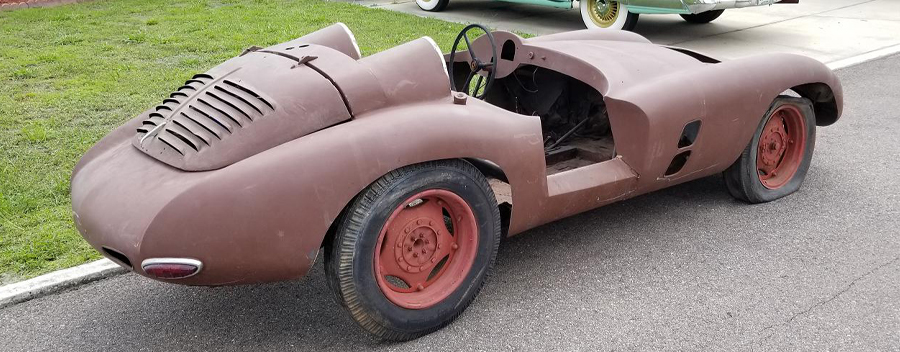
Above: The Renault-Devin Special Owned By Luis Alarcos Has Such A Cool Look
Hi Gang…
I love Renault based American Specials – and most of you know why.
My first fiberglass sports car was the 1962 Shark Roadster – a Renault based American sports car that I’ve had nearly 40 years. That car led to my research into Sharks and that experience led to my interest in handcrafted cars across the world and that experience led to this website and more. Whew! Too much to share. Anyway, those of you want to learn more about the Shark can click on the links below.
My First Fiberglass Car – The 1962 Tiburon “Shark” Roadster
So it’s not a big “leap” to understand why all Renault based specials interest me. My good friend Marvin McFalls, President of the North American Renault Owner’s Group and I, will soon be creating a section on Renault Specials in our website so watch this space – should be fun.
And think about this “Devin-Renault” combination – an American sports car special even though the Devin body was taken from an Italian styled sports car and the chassis / drivetrain is purely French. Those darn Americans….you never know what they’ll do next 🙂 Now on to today’s story – the Renault-Devin Special.
Luis Alarcos and the Devin-Renault Special
I met Luis Alarcos when he became interested in purchasing the Renault-based Devin Special that we had found in Oklahoma City, Oklahoma. It had been stored in a warehouse for 20+ years and the person selling it contacted me to see if we had interest. Here are some of the initial photos he sent me of the car.
Researching The Car
The Devin-Renault soon had a “special” new home in Tampa, Florida, and on June 3, 2018 the Devin arrived:
I love getting a chance to inspect handcrafted cars up close and personal when they arrive. There’s no better way to get to know the builder through the techniques they used to build the car. There are a variety of ways that a “Special” can be built and each one tells a slightly different “tale.” As you know, I’ve owned several Renault Specials and this one was built differently than all others.
A Renault in the 50s and 60s was a unibody car. Just like a Porsche 356, so when you cut the body off the pan, you have to strengthen it in other ways. This car only used a partial pan and additional frame rails were built to give strength to the chassis. It was nicely done, but interestingly the added frame rails only extended from the rear engine area thru the center door pan and stopped at the front door area – it did not continue further. See below:
A Renault is a rear engine car, and the trunk of the Renault 4CV donor car had been interestingly turned into the rear of the body – still covering the engine. Below you can see a restored Renault 4CV and how they used the trunk on the Devin-Renault Special:
The “5-star” wheels on the early postwar Renault 4CV’s have always been interesting to me. They are unique and I think have a rugged / attractive look for the car and are rarely found on specials in America. One of the reasons is that the more modern style steel rim wheel started around 1957 for Renault 4CV’s, and only one other Renault special in America that I know of sported these wheels – the prototype for the Shark roadster shown below.
The front is lacking a hood and the only access panel is for a battery – Renault’s rear engine cars located their battery up front. I think I may have opted for a symetrical hood. We’ll have to see what Luis will do during restoration.
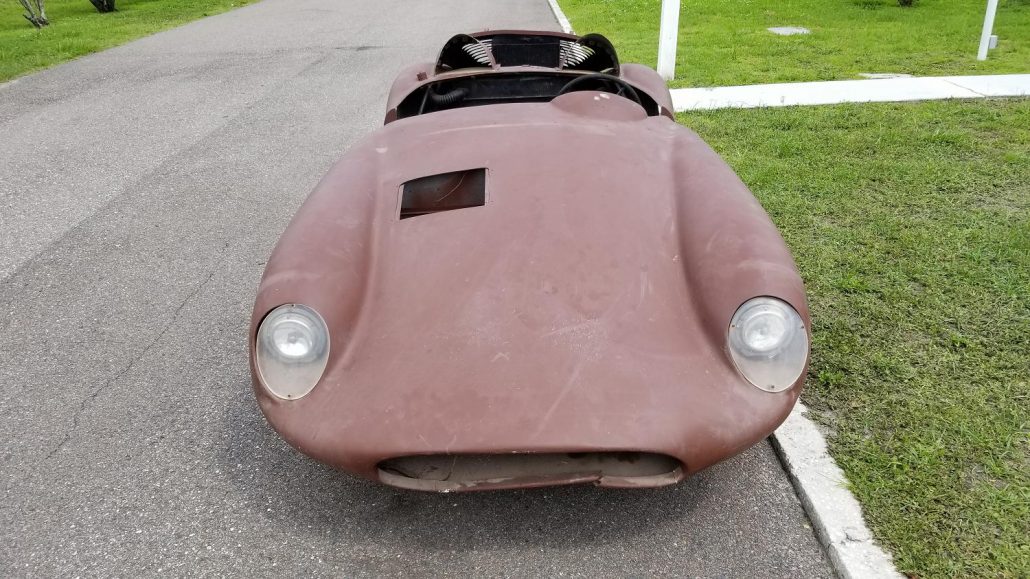 Restoration Begins
Restoration Begins
Back in April this year, Luis sent me a photo of the restoration as its begun – and I like what I see. The floor pan has been removed and no doubt plans are for a new one to be installed. That will be great because the chassis will be strengthened even more – excellent move Luis. And the fiberglass body looks good – nicely repaired or ready and waiting for finishing.
Luis is making such good progress I wish he lived here in the states so I could learn and watch more. Great job Luis!
Summary:
So we’ll continue to watch the restoration of Luis Alarcos’s Renault Devin from this side of the ocean and I’ll share more when I get a progress report and photos (keep ’em coming here Luis 🙂 And Luis….send some photos of Valladolid, Spain – I’d love to see the outside of your shop and some street scenes. For those of you interested, click here to learn more about Valladolid, Spain.
Those of you who would like to learn more about the Shark and other Renault based specials, click on the link below:
Click Here To Learn About Renault Based Specials From America and Across The World
Hope you enjoyed the story, and remember…
The adventure continues here at Undiscovered Classics.
Geoff








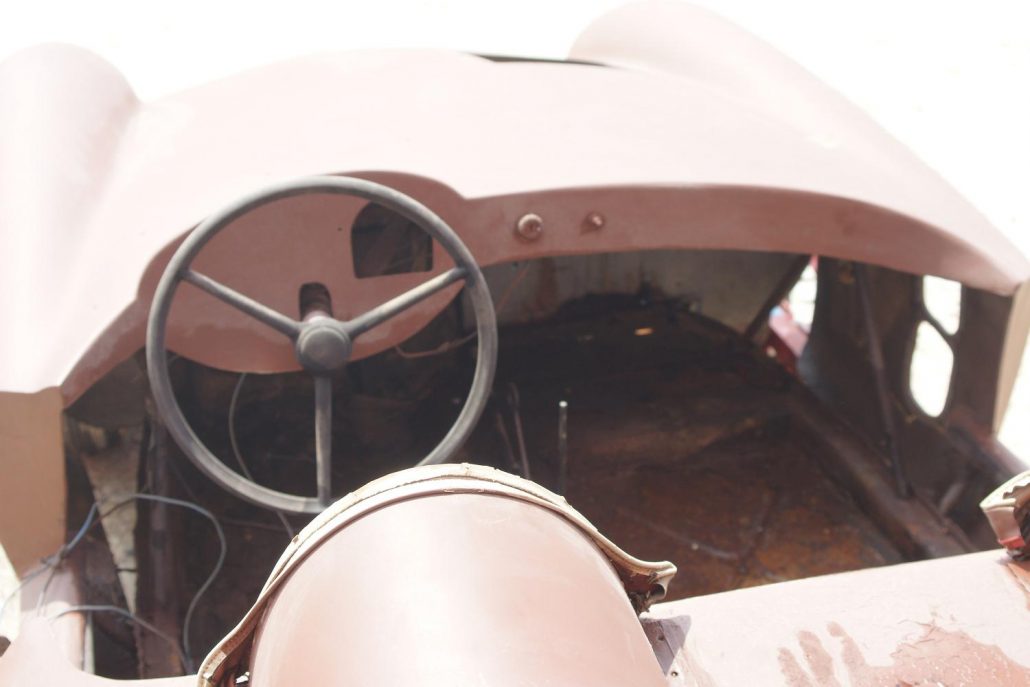




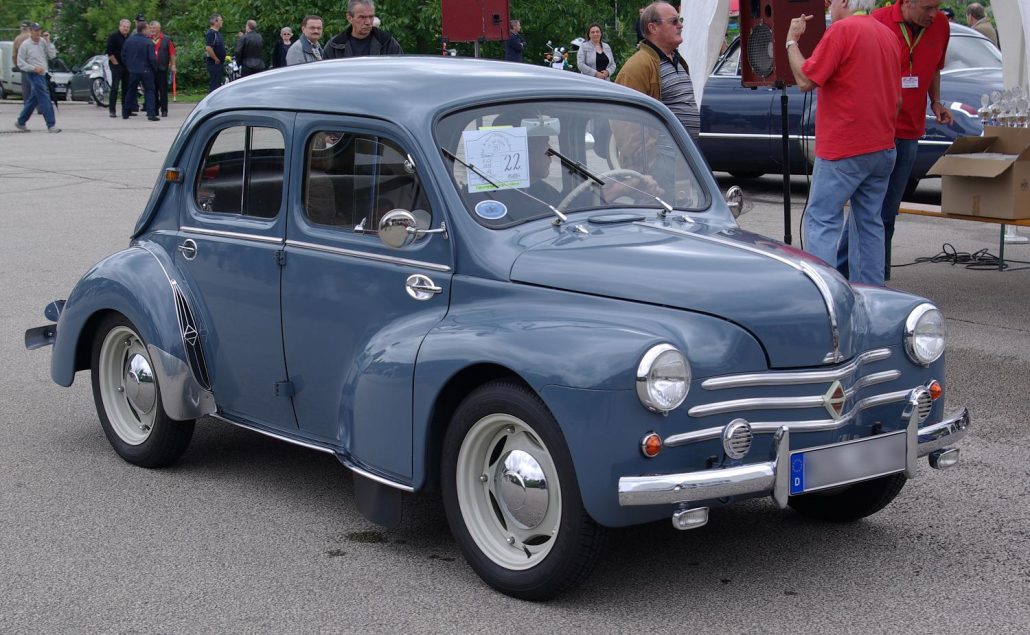
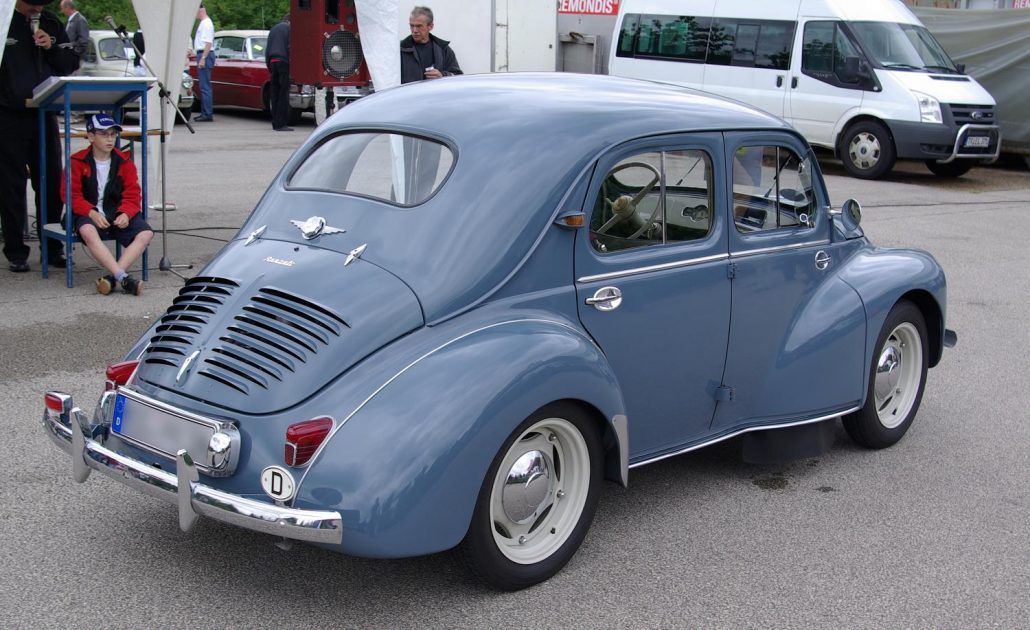




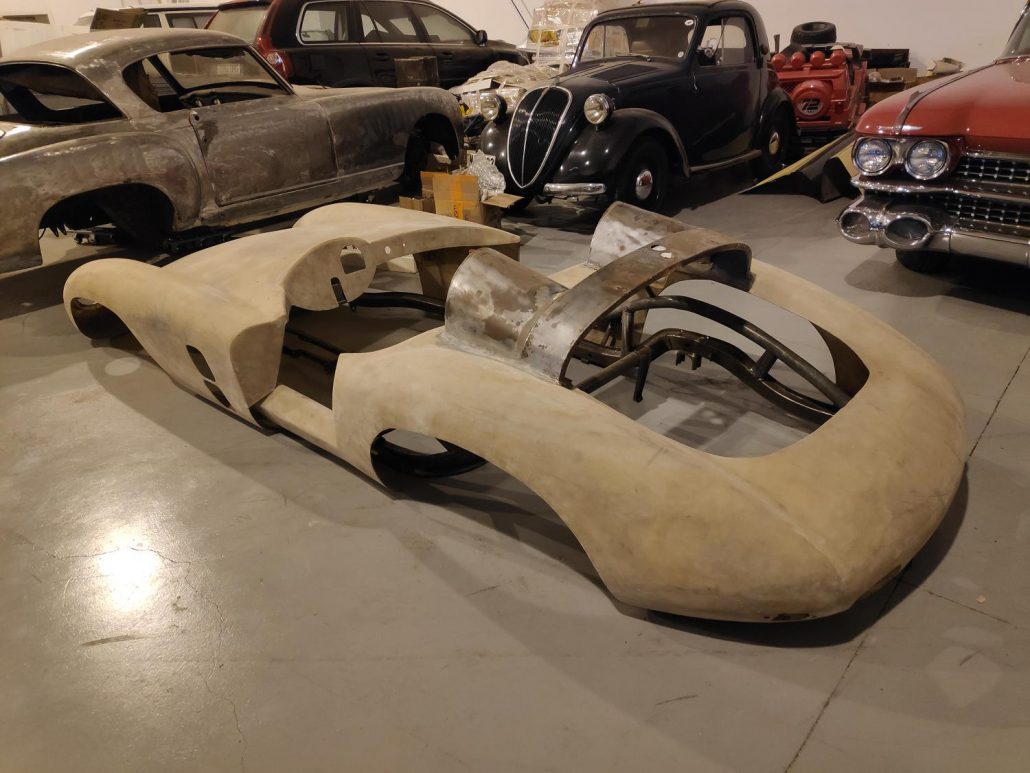
Dear Luis Alacros,
I’m Hugues Portron in charge of Renault Group’s classic car collection.
We are organizing the most important ever seen 4CV engined barquettes during the “Circuit des Remparts” classic event at Angoulême (near Bordeaux – France) in September 2024.
DB 1066, VP, Rosier, BMS, Colluci, Ferry, Riffard, Bunce… would be present (14 cars for the moment, about 20 expected).
We would be very honored to host you and your Devin Renault, even if the restoration is WIP. Do not hesitate to contact me for futher information (hugues.portron@renault.com).
Best regards,
Hugues Portron
hello I would like to know the history of this car and maybe be able to come and see it live, I am passionate about r4cv in Italy.
Dear Luis, How are things going with your wonderful Devin? I hope you are making great progress with the restoration. I keep coming back to the story on your car, since it has captured my imagination. Since your planning to keep the car original, I wonder how “street-able” it will be . If you don’t keep it original, I have the following ideas about the car. The looks are perfect. Kind of an Italian- Porsche by way of Devin. But I wonder how much fun it would be on the road, since it would clearly lack power. If you could find a Renault R-8 to use for parts it would produce a real sports car. The engine from an R-8 would have a five bearing crankshaft, with 1100cc or 1300cc cap. which would almost double the power.The gearbox is an all-sychromesh with ether four or five speeds. By replacing the the front cross member with one from an R-8, you would have a new ball-joint front suspention, and the negative camber rear susp.. Plus 4 wheel disc brakes. By extending the chassis tubes all the way to the front, the car would have more strenght to make the suspention work. Putting the radiator, battery and fuel tank up front would help balance the car’s weight. This would make the car as ‘hot’ as its looks. Just venting my ideas! All the luck with the restoration. Michael Lugo de Armas.
Dear Michael Lugo de Armas. Your ideas are very attractive but I always want to leave the vehicles in the state that the manufacturers or owners wanted to leave them. It is true that it would be very attractive to double the sensations, but soon I will be able to do it with the SWM Gordini that will arrive at my facilities and that Geoff has kindly provided me. Every car has its attractions and this Devin will not be the vehicle to win races, but it will be very pleasant to be able to enjoy its driving with peace of mind. That’s why I don’t want to put safety arches on it or use it to run races, I want it to continue to be the expression of its time. When I move forward in the restoration process, you will understand why I have decided to do so. I also really like the sensations of speed and acceleration, but each vehicle is the way it is. 😉
Ah Ha, your a purest ! And your purity is well explained. I am not such a purest, and have been in the past quite a “Hot Rod” kind of guy. I tend to modify my car to a level that I think are in keeping with the sprit of the car. My Morgan 1953 had 1995cc Triumph motor with a single carb and small brakes. So in went the big brakes from the last year of drum brake Morgan’s. Didn’t think that disc-brakes were in keeping with the look of the car. However the engine got the 2.2 cylinder pistons & liners, and dual SU carbs with a mild cam. Total of 110 horse power in a light car! Fun Car ! kept it for 27 years. Found a 1941 Hudson in unbelieve condistion except it had a cracked block and a bad tranny. The bad tranny meant that it was put up on blocks and the lack of anti-freeze cracked the engine. It became a wonderful street rod, with a Chevy V8 and auto trans and AC. The look of the car was pure 1941 but with the go of a modern car. Could I have restored it to original ?, yes, but I would have had a 1941 Hudson. In the end I got a car that took me everywhere.( Miami to L.A., twice) And was a rolling conversation every time I stopped. All the very best with the Devin. Un Abrazo Fuerte. Michael.
I drove a Spanish 4CV in Granada for a year. During that time I carried 20 kilos of sand in the front boot in order to give the car a better balance and grip. It tended to do wheelies if pushed hard. If the Devin is a street car you can keep it original, but if your going to race or rally the car then you’ll need the weight up front. The rad and the battery should be moved up front to put as much weight on the front wheels. A spring across the back to connect the rear axes and thus keep them from tucking under
during hard cornering would help a lot. Mucha suerte con tu magnifico Devin. Michael Lugo de Armas.
Michael, how lucky to have lived in Granada. It is one of the cities in Spain that I envy the most. As you know, on the same day you could go skiing in the morning and go sunbathing in the afternoon !!
As I said to John, it is true that almost all owners of the Renault had to put a punching bag if you did not want to have a scare in a turn.
Thanks for wishing me luck, I am very excited about the car and I think it will be very attractive.
I will take the opportunity to promote my country! 😉
I forgot to explain that the Sierra Nevada ski slopes
https://sierranevada.es/en/
are at 3.000m (10.000ft) altitude and 30mn by car from the beach!
https://www.turgranada.es/en/things-to-do/sun-and-beach/costa-tropical-beaches/
In addition to being able to see one of the wonders of the world that is the Alhambra in Granada.
https://www.alhambra-patronato.es/en
Hi Luis,
I doubt that the car would be a problem in normal street operation, but I suspect on the race track it would be very “tail happy” in the corners.
Like most projects you have to make some hard decisions about originality vs. improvement. If the car is to be a race car, eliminating the fan and moving the radiator to the front would make it a better car. Then you could also drop the headrests down and improve the lines in the rear. But then, it is not as it was…
I think everyone loves the Devin lines. The car will be a looker!
Hi David,
Normally I always put originality before modifications. But in this case, after checking that they must have ballasted the front of the car with concrete, I thought it best to try to do it in a more technical way. This way is putting the fuel tank and the radiator forward. It is a difficult decision for me, and I will probably keep the car in its original condition at first, and after driving it, if I see that it is impossible to use it under normal conditions. , then I will make these changes.
How interesting and wonderful to read of this special being restored. I’ve heard of many things to add weight at the front of a 4CV but concrete!! We used to have a 40 kg bag of cement in our R8, here in Western Australia where it is very windy.
The car seems to be based on an early 4CV, an R1060 car. One small modification I would consider is getting front and rear axles from a slightly later R1062. They look the same but have bigger stub axles, a better system holding the axle/wheel bearing in place (!) and bigger rivets holding the brake drum flanges to the hubs!
The wheel rims are very interesting – one looks normal and three look as if they have solid edges where the bead of the tyre is located. Rims like those three are very rare indeed, if I am interpreting the photos correctly, and maybe were only used on a few “pre-serie” cars made before full production started.
I’m glad to hear that you find it interesting what I’m going to do to restore this very special car.
It is true that the Renault with everything behind gave stability problems. In fact, in Spain the Dauphine was called the widows’ car. This was because many women became widows because their husbands died due to getting off the road with the car in one of those curves that were on the Spanish roads of the 50s. Like you did in Australia, in Spain they put a bag of sand in the front boot to compensate for the weights between the two axles.
As it will be a car that I will not use in racing, I will try to leave it as close to its initial design as possible. In this case, as the bodywork is so light, the weight problem worsens. So I will move the radiator and the tank to the front.
I will have to make an access to the tank and the radiator to be able to fill them. I will have to cut a symmetrical hood and I will use the same hinges as the rear hood.
The only problem that remains for me to solve is how to cool the radiator when the car has been stationary since the fan moves with the engine and I will no longer be able to because they are each on one side of the car! I don’t want to install a modern electric fan. Do you have any advice to give me?